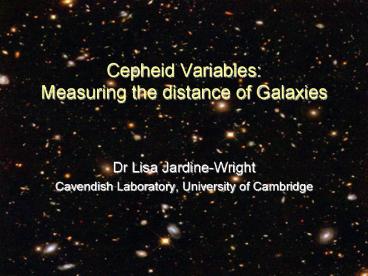Cepheid Variables: Measuring the distance of Galaxies - PowerPoint PPT Presentation
1 / 16
Title:
Cepheid Variables: Measuring the distance of Galaxies
Description:
Time in days. Apparent Brightness in Magnitudes. Data Table. HV 837. HV ... Absolute magnitude is what the apparent magnitude of the same star at 10 parsecs ... – PowerPoint PPT presentation
Number of Views:443
Avg rating:3.0/5.0
Title: Cepheid Variables: Measuring the distance of Galaxies
1
Cepheid VariablesMeasuring the distance of
Galaxies
- Dr Lisa Jardine-Wright
- Cavendish Laboratory, University of Cambridge
2
(No Transcript)
3
(No Transcript)
4
(No Transcript)
5
(No Transcript)
6
(No Transcript)
7
Measuring Distances
- How do we measure the distances of galaxies
outside our own Milky Way? - We use objects called standard candles within
each of the galaxies - Can be thought of as bright beacons which act as
reference points. For example, - Cepheid variable stars
- Supernovae
8
Cepheid Variable Stars
- Cepheids are special stars
- because they blink, whats
- more they blink at a rate that
- is precisely related to their
- brightness.
- If we can measure the rate that they are blinking
then we can infer how bright they are. - Then we compare how bright they look to us and
how bright they are as calculated from their
blink rate. - Distance
9
Why Do Cepheids Pulse?
- A cepheid is a young star which is burning
brightly. - He2 is more opaque and wont let the radiation
escape, so the radiation heats the gas within the
star - Heating increases the pressure of the gas and
this pressure pushes layers of the star outwards,
increasing its size and luminosity - As it expands it cools and becomes transparent
again.
10
(No Transcript)
11
Practical Cepheid Variables
- Using some real light curves for Cepheid
Variables we will measure the distances to the 4
galaxies to which they belong.
0
0
12
Measuring the Distance
- First of all we measure the light curve for the
cepheids in our distant galaxy to calculate the
period of its pulses. - The period of our distant Cepheid is then
compared it to observations of Cepheids in the
local Universe to calculate its luminosity
Apparent Brightness in Magnitudes
Time in days
13
Data Table
14
Calibration Line
15
Data Table
16
Final Step Distance
- We now know the real luminosity, L of the Cepheid
and we know the flux, F of light that we measured
from Earth ? distance. - Light energy from the Cepheid is emitted in all
directions. - Flux is the amount of energy that crosses a
square metre at a given distance, d.
d
17
Derivation of Distance Modulus
- A magnitude is defined as so that magnitude 0
corresponds to a flux F0 - Comparing to stars D and E
- Absolute magnitude is what the apparent magnitude
of the same star at 10 parsecs
18
Derivation of Distance Modulus
- Combining these equations (where distance d is in
parsecs)































